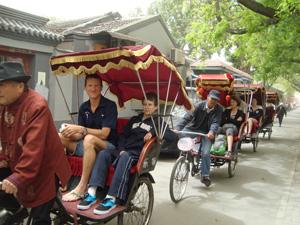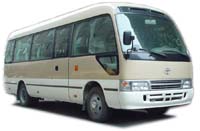|
In the morning, at about
7:30-8am, you will be picked up at your hotel by
your English-speaking guide and driver. From there
we will get started on the tour. First, we’ll
explore Beijing’s ancient city walls from north to
south (Desheng Gate – Dongbian Gate- Yongding Gate).
These gates are gone due to city expansion and wars.
Guests will learn the history of each gate by
listening to the guide’s introduction and by walking
along the gate. Standing on what is now Beijing’s
line 2 subway, these gates formed the backbone of an
immense city wall that protected the inner core of
Beijing. In its time, it was as monumental an
achievement as the Great Wall. You can imagine how
the old city of Beijing looked like by observing the
gates.
Next, we’ll visit the Beijing
Agriculture Temple (Chinese Architecture Museum &
Ancient Beijing City Micro Model). You will have the
chance to see how Beijing looked like in the past
dynasties of Ming and Qing by studying the largest
-scale model of the old capital while also learning
how Beijing’s old infrastructure migrated into a
modern one. The temple complex dedicated to Xiannong,
the father of agriculture, was built in 1420 below
the Forbidden City and adjacent to the famed Temple
of Heaven in Beijing. During the Ming and Qing
dynasties, a religious festival was held here each
year on the vernal equinox to welcome the season and
guarantee an abundant harvest. The emperor, along
with a parade of royal attendants and officials,
would process from his palace in the Forbidden City
south toward the Temple of Agriculture. There, in
Jufu Hall, he discarded his imperial robes and
donned farming clothes in preparation for the
Tilling Ritual. When the emperor had completed the
ceremony, he retired to Qing Cheng Palace on the
eastern side of the complex, where he rested and
entertained his entourage. This annual celebratory
rite was performed sporadically over the centuries
but ceased completely after Emperor Guang Xu’s final
demonstration in 1906.
Afterwards, we’ll head on over
to the Xishiku Catholic Church. Xishiku Cathedral
(or Beitang, "North Church" in Chinese, as it is
also known), is the grandest and most ornate church
in Beijing.
It is a cathedral belonging to the Catholic
denomination and is currently the location of the
Beijing Cardinal Bishop Office.
It is affiliated to the Patriotic Catholic
Church of China, a body with several major
differences to the official Roman Catholic Church.
The church was originally built by the Jesuits (a
Catholic order) in 1703 near Zhongnanhai, on land
granted to them by the Emperor Kangxi of the Qing
Dynasty (1644-1910) after he had been successfully
treated for a serious illness by the Jesuits. The
calligraphic couplets and plaque located at the
cathedral door were written by the emperor himself.
In 1887 the cathedral was moved to its present
location as the Emperor Guangxu wished to build a
park at Zhongnanhai, an area now used as the
headquarters of the Chinese Communist Party and
formerly home to leading Communists like Chairman
Mao, Deng Xiaoping and Zhou Enlai.
The cathedral was redesigned by Bishop Pierre
Favier in a Gothic style with a marble facade.
Bishop Favier is also famed for successfully
defending the cathedral and over 3000 Chinese
Catholic converts from 10,000 Boxers, who had
besieged it during the Boxer Uprising in 1900.
You’ll then have the
opportunity to do some shopping in Qiananmen.
Located at south of Tiananmen Square, the Qianmen
Business Street has been prosperous for more than
500 years and is home to most of Beijing's
time-honored brands. For elder Beijing residents,
there are places clearly known for certain goods.
For cloth, one would go to Ruifuxiang Shop; for
hats, to Majuyuan Shop; for shoes, to Neilansheng
Shop; for tea, to Zhangyiyuan Store; and for
watches, to Hengdeli Shop. All of these shops are in
Dashilan (or Dazhalan), a well-known business street
with a long history in the Qianmen area. The
recently reconstructed Qianmen shows the style of
old Beijing as well as the commercial atmosphere of
the Qing Dynasty better than before.
Following a lunch of Mongolian
Hot Pot at a local Beijing restaurant, you’ll be
taken on a
pedicab tour through the
Hutong area near the Drum and Bell Towers.
Hutongs are courtyard homes grouped together around
narrow alleys, and served as the lifeline and center
of everyday life in old Beijing. The Hutongs were a
critical component in the development and evolution
of Beijing folklore and culture. Going on this
Hutong tour, you will feel like you have traveled
back in time to a far different China, one where
there was still an emperor sitting in the Forbidden
City, and where there was still enough time to enjoy
the simple pleasures of common life. In addition,
you’ll also get to visit the homes of inhabitants
who have been living in these Hutongs for
generations. Some of the Hutongs were once home to
some of China’s most important court officials and
servants.
Next, we’ll play a
Hutong treasure hunt where you will get to find
a gift while playing. Think of it as a sort of fun
version of the Da Vinci Code. To cap off the tour,
we’ll take a leisurely stroll through the nearby
Shichahai lake area. Shichahai is a famous scenic
area that includes three lakes (Qian Hai, meaning
Front Sea;
Hou Hai, meaning Back Sea and Xi Hai, meaning
Western Sea), surrounding places of historic
interest and scenic beauty, and remnants of
old-style Beijing residences, Hutong and courtyards.
Shichahai is always a good place for local
Beijingers' recreational life, and in the last 200
years, many governmental officers, celebrities,
monks and nuns chose to build mansions, temples and
nunneries in Shichahai. Thus, Shichahai's attraction
lies not only in its natural beauty, but also in the
historical value of its architecture. The lakeshore
is packed with young people chatting, drinking and
generally relaxing as wood pigeons coo overhead. In
recent years it has become famous for nightlife
because it is home to several popular restaurants,
bars, and cafes. We’ll also walk through Yanandai
Xiejie (Tobacco Pipe Lean Street), a quaint
800-year-old hutong located directly north of
Yinding Bridge between Qianhai and
Houhai in the Shichahai area and south of the
Drum Tower. The street used to be well-known for
sellers of long-stemmed pipes, hence the name. Now,
it is a street lined with numerous antique stores
and trendy bars.
You will then be taken back to
your hotel and dropped off, thus ending your tour.
TOUR INCLUSIONS:
1 Hotel pick-up & drop-off service
2 Air-conditioned tour coach
3 English speaking tour guide
4 Entrance tickets as listed on the above itinerary.
5 Chinese lunch (Vegetarian? No problem!)
TOUR EXCLUSIONS:
1. Tip to
the guide
2. Personal costs
|



